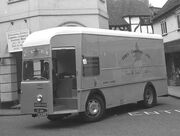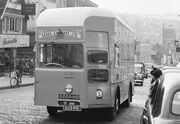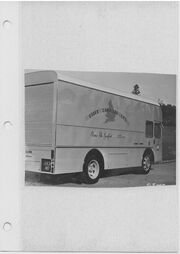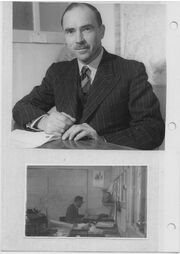
Paravan on a test drive
The Dennis Paravan story.
The Origin of a familiar sight. By Eddy Barber
During the 1950’s I was General Manager of Essex Carriers Ltd, in South Benfleet, Essex, which grew from having idle time with a builder’s lorry in the late Twenties into National Parcels and Goods Services run by my father-in law, Dick Brittain.
Origins[]

Paravan on test drive

Paravan 8539 NO
During my time it became a parcels and distribution operation covering all Essex and into parts of London and Suffolk. We had converted from a small fleet of drop side flats with, at the first, hoopsticks and tarpaulin tilts to standardized five ton box vans. First to go with these were rear half shutters and tailboards then whole shutters through variations on doors until we settled on double fold doors that eventually we hung to slam shut if the vehicle moved off with it open, secured with a Yale lock.
Occasionally I would go out with a driver if there was some problem with access to a delivery point or similar. and it dawned on me that a great deal of energy went into climbing out of the cab, walking around to the back and clambering up into the body clambering down and climbing back in the cab afterwards.
I also found that the manufacturers did not seem to studied ergonomics at all when designing getting in and out of the driving seat. In fact, some Fords we had at the time were not only devils to get in and out of but downright uncomfortable just to try to operate, with the gear lever nearly level with ones shoulder for a short person like me.
I put to Dick the idea of putting access to the body at the front as well as the back and after a great deal of casting up blind alleys, I settled on what became the Paravan, for which Dick provided the first basic design. The body form was an easily decided on between us eventually, but the chassis to carry it proved a major sticking point.
It called for a really low dropped front driving position forward of the front wheels and the lowest possible chassis height.
We shopped around the manufacturers who built in the three to five ton range and they were polite but dismissive of such a crackpot requirement. Firstly they could not conceive sufficient demand to justify initiating a production line and could not see where they could accommodate a small detail like the engine.
Which led us to Dennis of Guildford, who, making fire engines, ambulances, dustcarts and other specialized vehicles had rather more open minds that others. Not only did they solve the problem of the engine but also the snags that arouse in how to accommodate the controls to the gearbox but also steering with the front wheels behind the driver, not something at all common in those days.
The design[]
By adapting one of their other specifications they came up with a three-tonner with a body floor height of around three feet three inches. They devised a flat-four diesel they put in the middle of the chassis with access by would step down about six inches, turn left and step up about twelve inches into the body.
One mistake we made was to make the front door on the angle rather than having a flat front, which would have obviated complicating the body work, but it seemed a good idea at the time.
Dennis were able to turn out two chassis, more expensive that something off the standard production line, but we thought them a good investment. At the time we built all fleet’s bodies in house to a standardized pattern but this one had to be put out to Sparshatts the body builders, who rather doubtfully followed our requirements most efficiently. It was originally was to be named the Parcavan to connect with Parcels by function and the company name, but Paravan tripped off the tongue more easily.
Operational issues[]

Dick Brittain & Eddy Barber
To our surprise, our major problem then was getting them accepted by the drivers. The first stumbling block was the novel concept of loading front to back. It seemed to be some heresy of the Driver’s Creed.
Sitting in front of the front wheels took some getting used too. But gradually, when it sank in that working on such a vehicle was mush easier and less tiring, especially in the city streets where most of the work was, and the vehicles proved easier to winkle into restricted spaces at the kerb.
But the cost of building such a specialized Dennis did actively market the new concept, and the sales brochure is available to purchase on line. Of course, some years later when we instigated a productivity scheme that tied earnings to number of deliveries they really came into their own. But that is another story.
Looking back over the decades, I am going to make what I think is a justified claim that Dick Brittain and I invented the walk-through parcels van operated in their thousands by myriad organizations like UPS and other such giants. I wonder if a Paravan is languishing in a wood or a field or some farmer’s barn waiting to take its place in the history of transport as we know it today?
Preservation[]
- If you know of an examples surviving please let us know !!
See also[]
References / sources[]
By Eddy Barber
External links[]
- add any web sites with photos or additional info here.
| ||||||||||||||